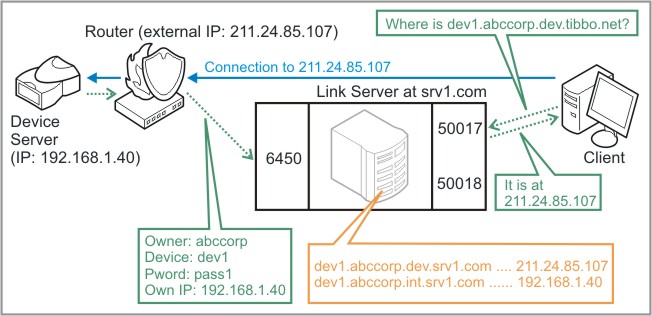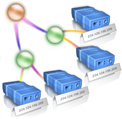Dynamic DNS Service
The downside of the Iotellect Server is that it is slower than direct connection, because all the data must go through the Iotellect Server. This isn't critical for systems that do not produce a lot of traffic per each node. Still, there are times where you might want to create a direct connection to a device (for the sake of speed), but the IP address of this device changes from time to time (as is the case with most ADSL connections). You need a way to track the device down -- a way to overcome this and connect to one 'stable' address. You need to know that this address belongs to the Device Server you want, and be able to rely on it. This is where the dDNS Service comes in. With dDNS Service each of your Device Servers gets a "host name", which looks something like |
|

Since the actual connection is established directly to the Device Server you would have to be able to reach it -- i.e, if it has a firewall protecting it, the firewall must be appropriately configured. Configuration would be more complex than with the Link Service, but you would gain an increase in communications speed.
 | In Dynamic DNS mode, Device Servers connect to the Iotellect Server on startup only, after obtaining IP address from DHCP server. After their registration in DNS they break connection with the Iotellect Server and act exactly as "normal" Device Servers, having no relations with Iotellect Server and other parts of Iotellect. In contrast to Link Service mode, no connection between Device Server and Iotellect Server is maintained. No data is transferred through the server. |
Implementation Details
On the Device Server side, dDNS is enabled through dDNS registration (DD) setting. When this setting is at 1 (enabled) the DS registers on the dDNS Service as soon as it is powered up. During registration, the Iotellect Server creates two DNS entries: one for the external IP-address of the DS, and another one for its "internal" IP address.
Example of two DNS entries for the same Device Server:
For external IP address: dev1.abccorp.dev.srv1.com
For internal IP address: dev1.abccorp.int.srv1.com
Dev1 is the device name, it comes from the Device Name (DN) setting of the DS.
Abccorp is the owner name, it comes from the Owner Name (ON) setting of the DS.
Resulting host names are no different from any other host name (or URL) that you have ever used. Input such a name as a destination in any software that can connect to your Device Server and this name will be automatically resolved into current IP-address of this Device Server! This functionality is based on an industry-standard DNS protocol, so no special drivers or software are required for this to work. Device Servers are registered on the external DNS server, like BIND for *nix or Windows DNS Server.

Only those Device Servers that are registered at the Iotellect Server can connect to the dDNS Service. Each DS is identified by the Iotellect Server through a combination of data in its Device Name (DN), Owner Name (ON), and Password (PW)settings.
DNS Server Compatibility
Dynamic DNS service is compatible with all DNS servers supporting dynamic updates, including Bind, Windows 2003 DNS Server, and more.
the Difference Between Internal and External Addresses
The difference between the two types of addresses is rather simple. Usually the DS connects to a WAN through a router (firewall) which, in effect, "masks" the IP of the DS. So the DS can be, for instance, at 192.168.2.100 within its network segment (this is its "internal" IP), but the outside world sees it under a different IP address. This is the "external" IP of the DS. So, to recap:
- The "internal" IP is the actual IP address of the DS itself, such as 192.168.1.40. It is used within its own specific network segment.
- The "external" IP is the IP of the router which is set to forward the data to the DS on the inside. (Once more, this router will have to be set to do so -- this is not an automatic procedure, and is quite in addition to registering the Device Server in dDNS).
To reach a DS from outside of its network segment you would need to use the external IP address. However, if you connecting from the same network segment you will need to know the device's "internal" IP address. This is why the Iotellect Server employs two types of dDNS records.
Was this page helpful?
